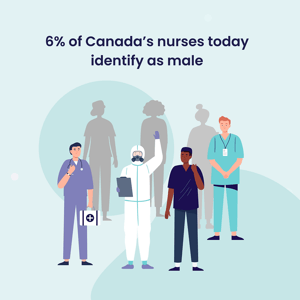Nurses have been hit hard by the pandemic, with many in Canada retiring early, moving to part-time work, departing hospitals to work for private staffing agencies or even leaving the profession. The pandemic has also sparked new trends in the field of nursing that will have a significant impact on the future of the profession.
In this article we look at 7 nursing staff trends to watch in 2021:
1) Increased demand
Now more than ever, Canada needs nurses. In the wake of the COVID-19 pandemic, thousands of jobs are expected to open for nurses across the country; according to the World Economic Forum and Conference Board of Canada, the country will need over 60,000 nurses by 2022, with that number set to increase to some 142,000 nurses over the next ten years!
While the nursing shortage is a stress factor for healthcare administrators, it’s great news for those new graduates seeking employment opportunities. Nurses working in Canada earn anywhere from $42,000 per year as a nurse’s aid, to almost $130,000 as an experienced registered nurse. Nurses also enjoy a variety of work benefits, paid vacation, extended healthcare, and pension plans.
2) High profile
Since the beginning of the pandemic, nurses have been at the centre of the news cycle, with stories of the care nurses provide on nightly newscasts and spread across social media feeds. This has led to an increased interest in the profession, according to nursing associations in Canada and the United States. The profession’s competitive salary, flexible location, multiple career paths and opportunities for advancement also continue to contribute to its ongoing popularity.
3) Education
In the face of the ongoing Covid-19 pandemic, more nurses are choosing to continue their education by attaining higher education degrees or short-form online courses. Programs that focus on leadership cultivation and business management skills are of particular interest, with nursing staff recognizing the importance of increased education to allow them to succeed in the business of healthcare.
Recognizing the increased demand for nursing education, many universities have increased their online course offerings for nursing programs, opening the door to nurses seeking higher education without the need to sacrifice work-related responsibilities or family obligations.
4) Telehealth and triage hotlines
With telehealth technology, patients can manage certain aspects of their own health care by accessing an online portal to see their test results, schedule appointments and request prescription refills. Virtual appointments also enable them to see nursing staff via live video feed. A convenient way to access non-emergency healthcare, it’s no wonder that telehealth visits increased by 154 percent in 2020.
Nurse-triage hotlines also provide patients immediate access to remote nursing care. Nurses use clinical guidelines to assess illnesses and provide recommendations on the type of medical care needed.
Telehealth visits and triage hotlines are a boon for nursing staff who can use the technology to manage patients who have mobility challenges or who are at high risk if exposed to the coronavirus.
5) Tech Boom
Technology continues to have a significant influence on the nursing profession, with nurses using a variety of data-driven technologies to perform their jobs. From automated IV pumps and portable monitors to smart beds, wearable devices and electronic health records, nurses today need to be aware of the latest technology and apps as the tech boom in healthcare will continue to be an important aspect of the profession.
6) Rise of Geriatric and Palliative Care
As the Canadian population gets older, the need for geriatric and palliative care nurses will increase. The time is right for nurses interested in geriatric and senior care to increase their education and skill set in this highly sought-after, specialized area.

7) Male Nurses
Though traditionally a female dominated profession, the nursing field is beginning to diversify, with a trend toward an increasing number of men in the field. Across Canada the number of male nurses has doubled over the past decade, with 6% of Canada’s nurses today identifying as male. That number is expected to continue increasing, as more men realize the benefits of a career in nursing.
Pre-pandemic, the healthcare field was already undergoing significant transformation. As we move into the post-pandemic next normal, nurses will have an opportunity to take on expanded roles, fill drastic employment gaps and benefit from advances in healthcare technology.
Learn how BookJane helps health care facilities improve shift fulfillment by 40%, dramatically decrease their time to fill shifts, and significantly reduce burdensome scheduling and administration time.





